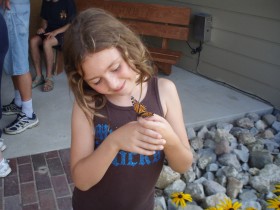 Thanks to the Northeast Wisconsin Audubon Society, one of our most popular activities–Monarch Tagging is scheduled for Saturday, August 25 at 1:00. Not only does capturing, tagging and releasing monarchs bring participants in touch with nature in a truly intimate way, but the activity is part of an international research effort.
Thanks to the Northeast Wisconsin Audubon Society, one of our most popular activities–Monarch Tagging is scheduled for Saturday, August 25 at 1:00. Not only does capturing, tagging and releasing monarchs bring participants in touch with nature in a truly intimate way, but the activity is part of an international research effort.
We are going out on a milkweed stem, scheduling the program at bit earlier than other years. But everything this season has been early. If we miss migration completely, that may suggest that butterflies respond to photoperiod (which many researchers believe) rather than weather.
The Ann Shebesta, the Butterfly Lady of Mishicot, returns with her lively program for children and adults. After an indoor introduction on the monarch life cycle and instructions for the handling the insects without injuring them, nets will be handed out.
Participants will be encouraged to feed the butterflies before releasing them. It’s an almost magical feeling to hold these seemingly fragile creatures, knowing that they will soon fly all the way to Mexico. And we love to point out that monarchs tagged at Crossroads have been recovered in their wintering area
Participants may bring their home-reared monarchs for tagging if we have enough tags left. Program will be held even if it rains.
But if the weather is good, whatever the timing of migration, we expect to have butterflies, thanks to the Heritage Garden at The Crossroads, a project of Master Gardeners of Door County. Like many pioneer gardens, the Heritage Garden is a vegetable garden with flowers around the perimeter. This makes for a pretty landscape, but the more imporant purpose of the flowers is to attract insect pollinators.
Gardens that fail to produce vegetables and fruits are most likely lacking the pollinators. A few crops are wind-pollinated—corn comes to mind– but almost all of the plants in the Heritage Garden require or at least benefit from being visited by bees (native or domestic) butterflies and wasps. So the best way to have a productive garden is to attract and meet the needs of insects.
Researchers tell us that color is the best way to “advertise” for insects. Bees are strongly attracted to yellow and purple flowers, but are apparently unable to see the colors on the red end of the spetrum. Butterflies can see red but are more likely to notice clumps of flowers rather than individual blossoms.
Because we work very hard to make the garden historically correct, the Master Gardeners insist on plants which would have been available in 1900. Using heirloom plants turns out to be an excellent practice. Modern plant breeders have come up with blossoms that are extraordinarily gorgeous–to humans. But insects can’t reach the nectar in double-flower hybrids. And often, bred for stunning colors, flowers produce less or even no nectar and pollen. And the colors we love—tangerine and lime green seem to be the fashionable colors this year–are essentially invisible to bees and they do nothing to help a vegatable garden become productive.
 And speaking of fasion, “Fashion of Yesteryear” will be the program and the Sunday in The Village program on Sunday, August 26. At 2:00 Ruth Scholz will present a trunk show, using her extensive collection of period clothing. She will talk about the fabrics, styles, and have something share about what fashions reveal about the times.
And speaking of fasion, “Fashion of Yesteryear” will be the program and the Sunday in The Village program on Sunday, August 26. At 2:00 Ruth Scholz will present a trunk show, using her extensive collection of period clothing. She will talk about the fabrics, styles, and have something share about what fashions reveal about the times.
1:30 Family Program: Moon Struck
Saturday August 25, 1:00. “Monarch Tagging “ Northeast Wisconsin Audubon Society presents Ann Shebesta, The Butterfly Lady of Mishicot. After an indoor introduction on the Monarch life cycle, nets will be handed out to see how many participants can catch and tag. Participants may bring their home reared monarchs for tagging if we have enough tags left. Program will be held even if it rains. Free. Meet in the Collins Learning Center.
Sunday, August 26 1:30-3:00 Sunday in The Village Members of the Door County Historical Society will offer tours of the buildings in The Village and will be selling refreshments. At 2:00 Ruth Scholz will present “Fashions of Yesteryear” –a trunk show using her extensive collection of period clothing. She will talk about the fabrics, styles, and have something share about what fashions reveal about the times. Free and open to the public.

